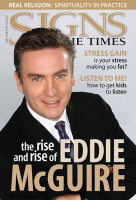The difference between fact and truth is a matter of faith.
Hence, the fact is a person cannot walk on water; the truth is that Jesus did. Fact relies on numbers—if the numbers don't add up, the “fact” doesn't either. But does “truth” rely on numbers? I never thought so, until I realised that much of the beauty of music, art, literature and philosophy also has a mathematical quality to it. In the Bible, that maths is often explicit. The numbers one to seven all contain Hebraic cultural meanings and are often used to denote those meanings rather than to specify an actual quantity.
But numbers are also implicit in the literary articulation of biblical truth.
Over the millennia, scribes known as sopherim have been commissioned to transcribe copies of the Hebrew bible, the Pentateuch—the five books of Moses—or Torah. Sopherim worked with great care and accuracy, because they used numerical writing techniques and stichometry to ensure that each copy they made was free of mistakes. Numerical writing involves writing according to fixed metrical patterns; stichometry is the practice of counting syllables as elemental units of each stich (rows of verse), of each stich in every verse, and of every verse in each strophe—all of which make up part, or a passage, of Scripture. In other words, through the work of sopherim, we find that some biblical authors wrote to strict numerical patterns and then composed their sacred writing in stichometric layout in order to ensure accuracy.
By the early centuries BC, the sopherim were so reliable in their techniques they could name the exact middle letter of the Bible, the two middle words, the verse that contained them, and whether this verse fell in the first or second half of the Bible. This concern for exactitude helped to make Scripture “sacred.” It also kept the versions of the Torah constant for 2000 years. It is said, to resolve an argument among some sopherim rabbis as to the middle letter/word/verse of the Torah, they simply got out the Torah and recounted.
Evidence for stichometric composition should not be overstated, but can be seen in texts such as the Creation account of Genesis 1:1-2:3, where Genesis 1:1 is made up of seven words, and Genesis 1: 2 comprises 14 (2x7) words. The seventh paragraph of this same passage deals with the seventh day and is made up of 35 (5x7) words. Three successive clauses are found in this part of the Creation account (2:1-3) each bearing the phrase, “the seventh day” and each phrase (2; 2a; 2b; 3a) is made up of seven words. Moreover, the sections of Genesis 1 dealing with the first, second, third and fourth days of creation are made up of 207 words in three lots of 69 words each. The fifth and sixth days are made up of 206 words. In each section (days 1-4 and days 5-6), God speaks five times. And so on.
Another type of stichometric composition can be seen “in the size of the text, measured in numbers of words, and the numbers in the text itself,” as Menken puts it.
For example, 1 Kings 18:20-46 is made up of 452 words. This is the sum of the numbers mentioned at the beginning of the story in the text—that of 450 prophets of Baal and two bulls. Exodus 24 also bears the same internal and external symmetry: 252 words (70+1+12+12+0.5+0.5 +70+6+40+40) made up of the sequence of numbers mentioned in the text. Other patterns are found throughout the Bible such as in Zephaniah 1:4-6, which begins with three lines of 10 syllables each.
These are followed by lines that grow in neat mathematical orders of six (6+5, 11+6, 17+5, 22+6).
In the New Testament, Matthew's account of Jesus' Sermon on the Mount is composed of two equal sections (5:3- 6; 7-10) of 36 words each. Matthew 14:22-33 tells of Jesus walking on the water in 31 words of discourse and 155 (5x31) words of storytelling. In the story itself, there are three subsections of 31 words each. The central verse of the story is Jesus' revelation to His 12 disciples, made up of 12 words, and is preceded and followed by sections of 87 words each. In Mark 3:1-6 the story of Jesus healing a man with a withered hand is told. It is structured in terms of an introduction of 13 words, three paragraphs of 26 (2x13) words each and a final phrase of three words. In Paul's writings, Philippians 2:6-11 is made up of two sections (2:6-8; 9-11) of 90 syllables on each side of the central syllable. The first section deals with Jesus' humiliation; the second section deals with His exaltation.
Numbers are also central to biblical religion in a quite different way. In a recent essay, Charles Edward White, professor of christian thought and history at Spring Arbor University, summarised numbers from astronomy, physics and theoretical mathematics that point, by inference, to the idea, if not existence, of God.
For example, from astronomy, the chance that our universe happened by chance is one in 1010123.
I can't picture a number that big, but it is sufficient to make me uncomfortable with a random evolutionary process. According to another expert, the series of numbers that specify the various forces that comprise our universe must be met with precision or else—or else our universe would not have turned out the way it has. For example, the nuclear force that holds neutrons together in matter is exactly 1034 times stronger than the force of gravity, but it only operates at subatomic distances. If we were to change that relationship, the world as we know it would cease to exist.
Or consider the fact that there are some 1082 elementary particles responsible for our universe. Reality has come into existence through particle mutation and the fastest rate of particle mutation is calculated to be 10 -44 seconds—known as Planck time (after Max, the physicist who worked it out as the speed at which two photons pass each other, which is the speed of light). If this rate were to be applied to the very first particles and every other one since the earth presumably exploded into existence 15 billion years ago (the “Big Bang”), the universe, according to White's sources, would have to be “a trillion quadrillion, quadrillion, quadrillion, quadrillion, quadrillion, quadrillion, quadrillion, quadrillion, quadrillion, quadrillion” times older than it appears to be. It isn't, hence the Darwinian model should be left out of the calculations.
Space doesn't allow a comprehensive review of all the numbers that fascinate, but it is clear that numbers add up in the text of truth, and in the truth of reality, as we know it. Numbers work inside the Bible text and outside of it. They have an internal literary application and an external material consistency. They work in science and in nature, as well as in biblical literature. Indeed, there isn't a sphere where the numbers don't add up to something greater than themselves— God. Moreover, when the Bible suggests that we and everything about us are numbered, it means it (see Matthew 10:30). Our numbering is not a matter of chance; we are not lucky numbers born of coincidence. The numbers in the biblical text and in nature are deliberate codes to convince us of a design that is logical ( Logos ) in its intent, but, more importantly, mindful of our predicament.





